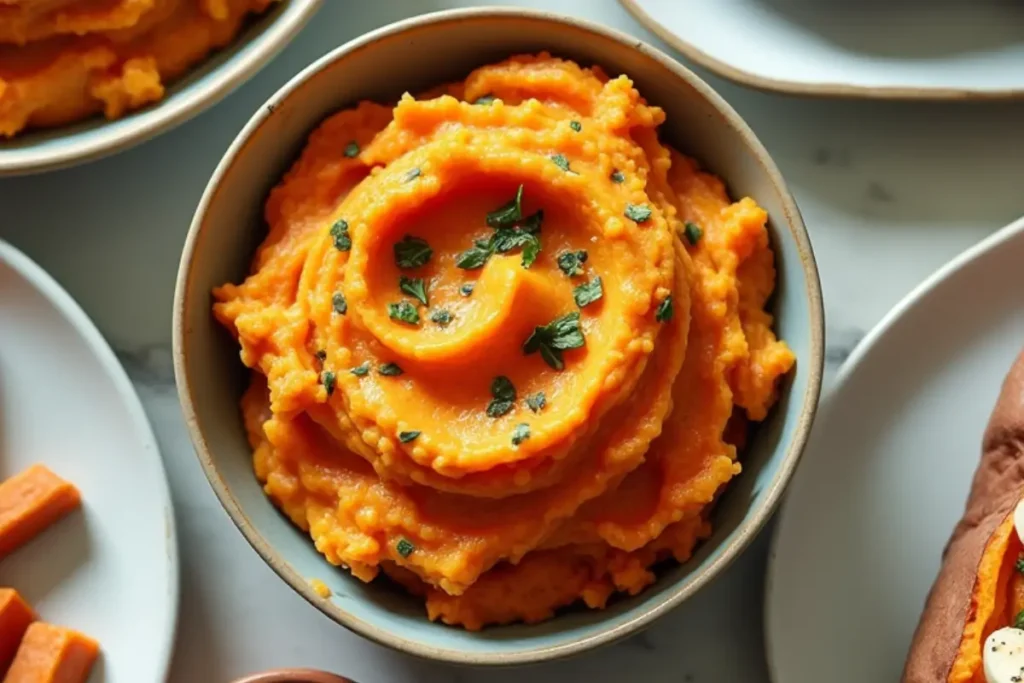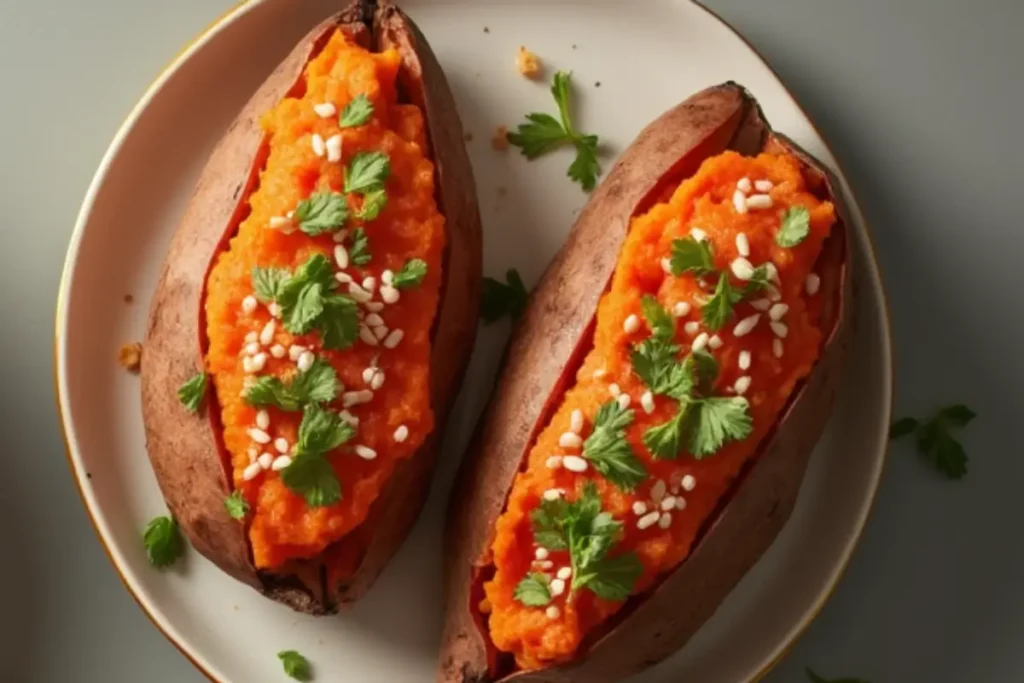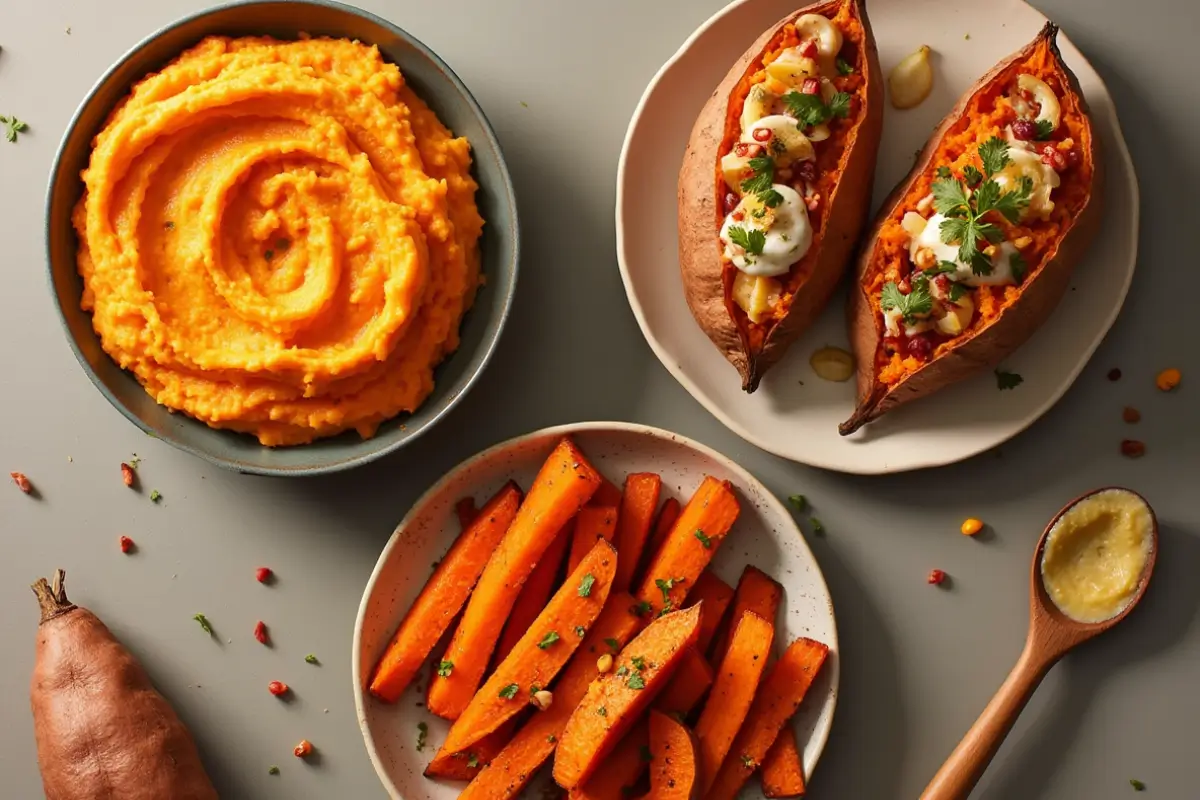Ever find yourself staring into your kitchen, contemplating the best way to prepare those vibrant orange sweet potatoes? After a long day, sometimes all you crave is something warm, comforting, and utterly delicious, and you might even find yourself wondering, is it better to boil or bake sweet potatoes to achieve that perfect side dish? It’s a common kitchen dilemma, and consequently, your quest for the perfect side dish is about to get a whole lot clearer. Therefore, let’s dive into this culinary conundrum together and explore the best way to cook these nutritional powerhouses. Indeed, you’ll be amazed at what we uncover.
Understanding the Sweet Potato Basics
Before we delve into the great boil vs. bake debate, let’s first take a moment to appreciate the humble sweet potato. It’s not just a tasty treat; indeed, it’s a nutritional powerhouse, packed with goodness that can benefit your body.
Sweet potatoes are an excellent source of vitamin A, which is, absolutely crucial for eye health, and vitamin C, which furthermore, supports your immune system. Furthermore, they are also a great source of fiber, thus promoting good digestion and helping you feel full and satisfied.
Moreover, beyond vitamins, they’re also full of antioxidants that protect your cells from damage. These root vegetables come in various forms, from those with deep orange flesh to others with a pale yellow hue; however, the core nutritional benefits remain largely consistent.
So, as you, then, plan your next meal, remember that a sweet potato is not just a flavorful choice, but a healthy one as well. In short, they’re quite remarkable.
The Case for Boiling Sweet Potatoes
Boiling sweet potatoes is often a go-to method for those seeking quick results. But how exactly should you, then, approach it? Well, let’s walk through the process together.
First, give your sweet potatoes a good wash. You can choose to boil them whole or cut them into cubes. Cubing them will certainly reduce the cooking time. If you’re opting for whole potatoes, then, make sure to pierce the skin several times with a fork; this prevents them from bursting during cooking. After that,
Next, place your potatoes in a pot and cover them with cold water. Bring the water to a rolling boil, and then reduce the heat to a simmer. The cooking time will vary depending on the size of the pieces. Small cubes can be tender in about 10 to 15 minutes, while whole sweet potatoes may take 20 to 30 minutes, or even more, depending on their size. You’ll then know they are ready when a fork easily pierces through the center. It’s crucial to drain them promptly once they’re tender, to prevent them from becoming waterlogged. Thus, quick action is key.
Advantages of Boiling:
- Speed: Boiling is undeniably quicker than baking. This is particularly a lifesaver for those busy weeknights where your time is limited.
- Texture: Boiled sweet potatoes emerge with a tender and wonderfully moist texture, thus making them perfect for mashing or pureeing. Indeed, their texture is ideal for these purposes.
- Versatility: Additionally, they are incredibly easy to incorporate into soups, stews, and various other dishes. Moreover, their versatility is a major plus.
Disadvantages of Boiling:
- Nutrient Loss: Unfortunately, some water-soluble vitamins can leach out into the boiling water. To minimize this, try to use the cooking water in other recipes. However, this can be mitigated.
- Waterlogging: If they are left in the water for too long after cooking, or not drained well, they can therefore, become soggy and lose flavor. Consequently, timely drainage is essential.
Boiled sweet potatoes certainly shine in recipes where a smooth, creamy texture is preferred. For instance, imagine a velvety sweet potato mash as a side dish to your favorite meal. Or, alternatively, perhaps a comforting, creamy sweet potato soup is what you need on a cold evening. Furthermore, they also make excellent purees for little ones. In fact, these are just a few of their many applications.
To learn how boiling compares to other quick methods, explore how long it takes to microwave a sweet potato.
Quick & Easy Boiled Sweet Potato Mash Recipe
| Ingredient | Quantity |
| Sweet potatoes | 2 medium |
| Milk | 1/4 cup |
| Butter | 2 tbsp |
| Salt | 1/4 tsp |
| Black pepper | Pinch |
- Boil the sweet potatoes until they are tender, then drain.
- Place them in a bowl with the rest of the ingredients.
- Mash until you have achieved your desired consistency.
- Serve hot and enjoy! It’s that simple.

The Case for Baking Sweet Potatoes
Baking sweet potatoes is a method that brings out a different dimension of flavor and texture. Indeed, it’s a process that enhances their natural sweetness and creates a unique culinary experience for you. Moreover, it can truly transform the humble sweet potato.
To bake them properly, first, begin by preheating your oven to around 400°F (200°C). Wash and scrub the sweet potatoes, and, just like boiling, pierce the skins several times with a fork; this allows steam to escape while they bake. Consequently, this step is quite important.
You have the choice of baking them whole or halving them lengthwise. For halved sweet potatoes, you can add a little bit of oil to the cut surface before baking to help with browning and caramelization. Then, place your sweet potatoes directly on a baking sheet or on a baking dish. Depending on their size, it can take anywhere from 45 to 60 minutes to bake. You will know that they are ready when a fork easily slides into the flesh and the skin starts to wrinkle slightly. Therefore, watch for these signs.
Advantages of Baking:
- Enhanced Flavor: The baking process brings out the natural sugars of the sweet potato, thereby creating a beautifully caramelized flavor. In particular, the Maillard reaction, a chemical reaction between amino acids and reducing sugars that gives food its distinctive flavor, plays an important role in this process, enhancing that wonderful taste you crave.
- Nutrient Retention: Baking is a gentler way of cooking sweet potatoes, thus, helping retain more nutrients, including precious vitamins. Therefore, it’s a nutritionally sound method.
- Crispy Skin: Moreover, when done correctly, the skin of a baked sweet potato can become delightfully crispy, adding another layer of texture to your experience. Indeed, this contributes to the overall enjoyment.
Disadvantages of Baking:
- Longer Cooking Time: Baking usually takes longer than boiling, so therefore, it’s not ideal when you are in a rush. As such, plan ahead if baking is your chosen method.
- Oven Dependency: Of course, this method requires the use of an oven, which may not always be convenient. Accordingly, this limitation should be considered.
Baked sweet potatoes are perfect for recipes that call for a more robust texture and flavor. To illustrate, imagine a stuffed sweet potato loaded with flavorful toppings, or crispy sweet potato wedges served alongside a great meal. Sweet potato fries, baked to perfection, can be a healthy and delicious alternative to other types of fries, too. Furthermore, there’s a multitude of possibilities.
Curious about the texture differences between sweet potatoes and other tubers? Check out what is the difference between sweet potatoes and yams.
Simple Baked Sweet Potato Fries Recipe
| Ingredient | Quantity |
| Sweet potatoes | 2 medium |
| Olive oil | 2 tbsp |
| Paprika | 1/2 tsp |
| Garlic Powder | 1/4 tsp |
| Salt | 1/4 tsp |
| Black pepper | Pinch |
- Preheat your oven to 400°F.
- Cut the sweet potatoes into fry shapes.
- Toss the fries in oil and spices.
- Lay the fries in a baking tray and bake for 20 to 30 minutes, flipping halfway through.
- Serve hot and get ready to enjoy! They’re that easy to make.

Boiling vs. Baking: A Side-by-Side Comparison
So, which method reigns supreme? Let’s break it down with a side-by-side comparison:
| Feature | Boiling | Baking |
| Cooking Time | Faster | Slower |
| Texture | Moist & Tender | Slightly drier, caramelized |
| Nutrient Retention | Some loss | Better |
| Flavor Profile | Mild & Sweet | Intense & Sweet |
| Ease of Prep | Simpler | Slightly more prep |
As you can see, each method offers unique advantages. Boiling is in fact your friend when speed and a tender texture are your goals, whereas baking is perfect when you seek a more pronounced flavor profile and have time to spare. Thus, each has its place.
Which Method is Right for You?
Choosing between boiling and baking sweet potatoes ultimately comes down to your preferences, of course, your time constraints, and what you intend to do with them. Indeed, these are key considerations.
- Personal Preference: Think about the flavor and texture you enjoy most. Do you prefer a soft, creamy consistency or a more robust, caramelized flavor? Experimenting with both methods can easily help you determine your favorite. After all, personal taste is paramount.
- Practical Considerations: Are you in a hurry, or do you have plenty of time? If you’re pressed for time, boiling might be the best option. However, if time is not an issue, baking allows you to benefit from the enhanced flavor and better nutrient retention. Also, your equipment is something to consider. If you don’t have an oven, boiling is certainly your go-to method. In that case, it’s the obvious choice.
- Recipe Needs: Different recipes will call for different textures. If the recipe requires a soft, smooth texture (mashed sweet potatoes, purees, soups), boiling is the ideal option. If the recipe calls for a more intense flavor or a crispy texture (stuffed sweet potatoes, fries, wedges), baking is more appropriate. Therefore, let the recipe guide you.
The good news is that there’s no wrong answer here. Both methods deliver incredibly tasty and nutritious sweet potatoes. Indeed, your culinary journey is all about discovery! So, don’t be afraid to try both.
Want to experiment with an alternative cooking method? Discover how to prepare sweet potatoes in the microwave.
Frequently Asked Questions (FAQs)
Let’s tackle some common questions you might have:
- Can You Eat Sweet Potato Skin?
- Sweet potato skin is edible and contains fiber. Learn more about it in Do You Eat Sweet Potato Skin?.
- Does baking or boiling sweet potatoes make them softer?
- Boiling will typically make them softer, making them ideal for mashing and pureeing. In short, it’s the best option for softness.
- How long do sweet potatoes take to bake/boil?
- Boiling: Cubed sweet potatoes take about 10-15 minutes, and whole ones around 20-30 minutes, or more, depending on size. Baking: Takes approximately 45-60 minutes at 400°F (200°C). Therefore, plan accordingly.
- Do sweet potatoes lose their nutrients when boiled?
- They can lose some water-soluble vitamins during the boiling process. However, this is not to a significant extent. Using the boiling water in another recipe helps retain these lost vitamins. Thus, it’s not a major concern.
- Can I boil or bake sweet potatoes in advance?
- Yes, you can boil or bake sweet potatoes ahead of time and store them in the refrigerator for several days. This makes meal prepping much more convenient. Indeed, it’s a very helpful tip.
Conclusion
Whether you, then, opt to boil or bake your sweet potatoes, remember that both cooking methods offer unique advantages and are also equally delicious ways to prepare this nutritious root vegetable. Boiling is simply your quick path to tender goodness, while baking is the route to richer flavor and a touch of caramelization. In essence, both methods are worthwhile.
The most important thing is to find what works best for you and your taste. Don’t hesitate to experiment and discover your favorite way to savor these amazing root vegetables. Embrace the kitchen, embrace the learning and above all, embrace the culinary adventure. So, go ahead, grab a sweet potato, and decide: will you boil it or bake it? The choice is yours.
We’d love to hear from you! Have you tried both methods? What’s your preferred way to cook sweet potatoes? Share your thoughts and experiences in the comments below! And don’t forget to share this article with anyone you know who might be wrestling with this age-old kitchen question. Happy cooking! Let’s start a discussion!

